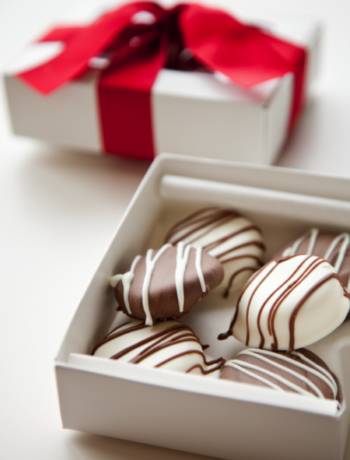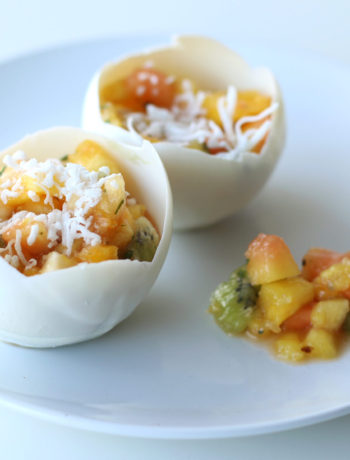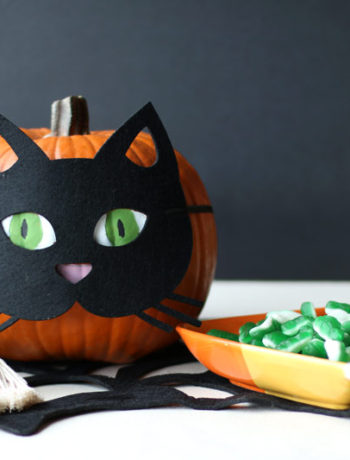There are a few different ways to temper chocolate. We’ve shared the seed tempering method with you. Now, thanks to our friends at Peter’s, we are sharing with you how to use the mush tempering method:
Using the mush method is the most “hands on” version for tempering chocolate. Unlike the seeding method, this option does not require the use of well-tempered chocolate as “seed”. In warm, untempered chocolate between 110-115 degrees F, all of the cocoa butter is completely melted and in the liquid phase. We cool chocolate while mixing/agitating until it turns to “mush,” thus the name. The change in color and significant thickening of this mush tells us that we have crystallized some of the cocoa butter in the chocolate from liquid to solid. The mush chocolate is approximately 76-80 degrees F. The chocolate can be cooled by a number of methods, including moving it around on a cool marble slab or mixing in a pan over cold water.
At this point, the solid cocoa butter crystals in the mush are a blend of both stable and unstable crystals. If we stop here and allow the chocolate to solidify to completion, the end product will be streaky and bloomed because the cocoa butter crystals will not finish solidifying in an orderly and stable manner. This is because of the unstable cocoa butter crystals in the mush.
To correct this, the mush chocolate is warmed to 86-88 degrees F for milk and white chocolate and 88-90 degrees F for dark chocolate, by the addition of some warmer chocolate. This melts away the unstable crystals but leaves behind the desirable ones. Ending the process below this important temperature leaves too many unstable cocoa butter crystals; too warm a temperature melts away too many cocoa butter crystals.
Instructions:
1. Start with melted chocolate between 110-115 degrees F (heat to 120 degrees F if starting with bloomed chocolate). Pour approximately 3/4 of the melted chocolate onto a marble slab or cooling table. Room temperature should be 62-68 degrees F for the marble slab. Water running through the cooling table should be 55-65 degrees F.
2. Cool the chocolate “mush” by moving the chocolate back and forth across the cool marble or table; a spatula works well for this. Continue with this until the chocolate is visually thickened and very viscous, but has not yet solidified. The temperature should be 76-80 degrees F.
3. Move the “mush” back into the bowl with the remaining warm chocolate (temperature should be 90 degrees F for milk and white and 92 degrees F for dark) and mix until uniform. Measure the temperature, which should be 88-90 degrees F for dark chocolate and 86-88 degrees F for milk and white chocolate. If too warm, put some of the chocolate back onto the cooling table and repeat the process. If too cold, microwave for a few seconds to reach the desired temperature.
4. To test temper, dip a metal spatula or knife blade into the chocolate and leave a small film on the blade. If the chocolate is firm, glossy and not tacky to the touch in 5 minutes at normal room temperature (68 degrees F), it is in good temper.
5. At this point, the chocolate is now precrystalized with the correct amount of good, stable cocoa butter crystals. Over time, these crystals will grow, so it is important to stir the chocolate occasionally to keep the crystals blended. The chocolate should be warmed slowly–a degree or two at a time–to maximum of 90 degrees F for dark chocolate and 88 degrees F for milk and white chocolate. To replenish supply during usage, slowly incorporate 90 degrees F milk or white chocolate or 92 degrees F for dark chocolate. This will keep the chocolate from getting too thick but still allow enough of the good, stable crystals to remain in the mix.
This method of tempering chocolate simulates how many automatic tempering machines work. In the machines, warm, untempered chocolate is pumped in and then through a heat exchanger with cooling zones; the ‘mush’ is created in one of these cooling zones. The ‘mush’ is then warmed up to the proper endpoint temperature in another warming zone. Tempered chocolate then exits the machine, ready for use.
. . . . . . . . . . . . . . . . . . . . . . . . . . . . . . . . . . . . . . . . . . . . . . . . . . . . . . . . . . . . . . . . . . . . . . . . . . . . . . . . . . . . . . . . .
Read our Troubleshooting guide to help you if you run into some problems with your chocolate.
Want to learn more about chocolate? Read our Chocolate 101 post.
All of this sound like too much work? We also love using COMPOUND chocolate- which doesn’t require tempering. Learn more about this fail-safe way to dip with chocolate.



